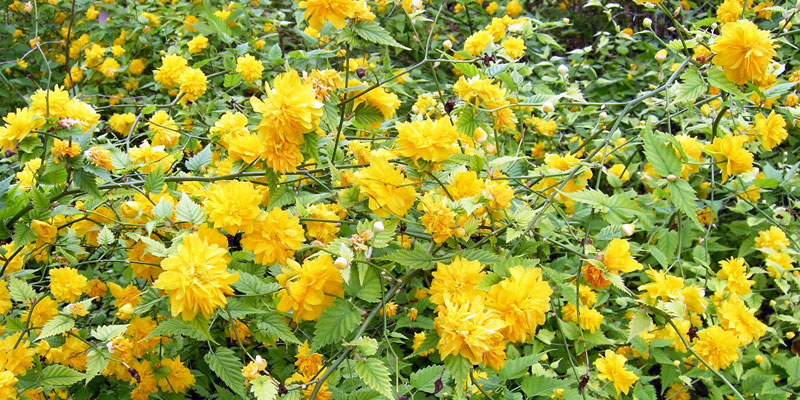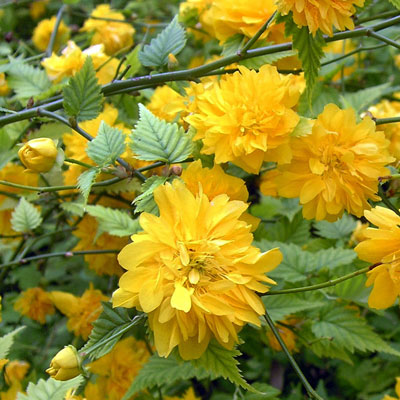A Source of Shade Color by Steve Huddleston
This is an old-fashioned, carefree and tough shrub that will brighten a shade garden with a profusion of yellow flowers in the spring. What’s not to like about that?
Japanese kerria is a deciduous shrub that forms a large, dense, twiggy mound. Its arching stems reach 5-10 ft. tall and wide. The stems are slender and green, and they assume a zig-zag pattern. The plants also sucker.

Kerria’s smooth leaves are about the color of Granny Smith apples, 1-3 in. long, pointed, and with prominent veins and serrated leaf margins. The leaves turn golden yellow in the fall.
Japanese kerria flowers are bright orange-yellow (the color of orange juice) and 1-1/2 in. wide. The double-flowering cultivar ‘Pleniflora’ is most common. It produces fully double, rose-like blooms that cover the shrub for several weeks in April and May. It will sometimes produce intermittent blooms in the summer. The flowers attract hummingbirds and butterflies.
Planting and caring for Japanese kerria…
Here are some basic pointers on planting and caring for this plant.
• Japanese kerria thrives in dappled shade, partial shade, or even deep shade. Those at the Fort Worth Botanic Garden grow beneath the ends of live oak branches and receive no direct sunlight. Morning sun is tolerable, but they must have shade from the afternoon sunlight.

• Plant Japanese kerria on 4-5 ft. centers (measure from the center of each plant). Because this shrub tends to sucker, it forms a large mass over time and demonstrates a medium to fast rate of growth.
• It prefers a loamy, well-drained soil of medium fertility, but it will tolerate clay if amended with expanded shale and aged compost to improve the soil’s permeability.
• Avoid heavy fertilization of kerrias because they will become weedy.
• Water Japanese kerria every week or two during the growing season.
• Once established, this shrub is tolerant of drought.
• It also demonstrates deer resistance and has no serious problems with insects or disease.
• The time to prune this shrub is in May or June after it finishes blooming.

Some additional facts…
• Latin name is Kerria japonica, and it’s in the Rosaceae, or Rose, family. It grows natively from central and southern China to southern Korea and Japan.
• Adapted to USDA Hardiness Zones 4-9, so it’s perfectly suited for all parts of Texas as long as it has shade.
• Works well in a pollinator garden. Fits beautifully in a woodland garden. Use also as an accent or specimen.
• Combine with other spring-blooming, shade-tolerant plants such as hellebores, azaleas and oakleaf hydrangeas.
